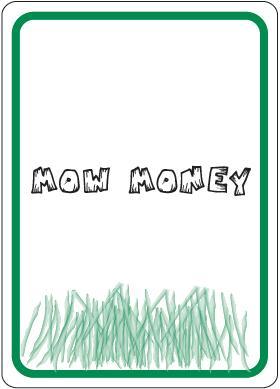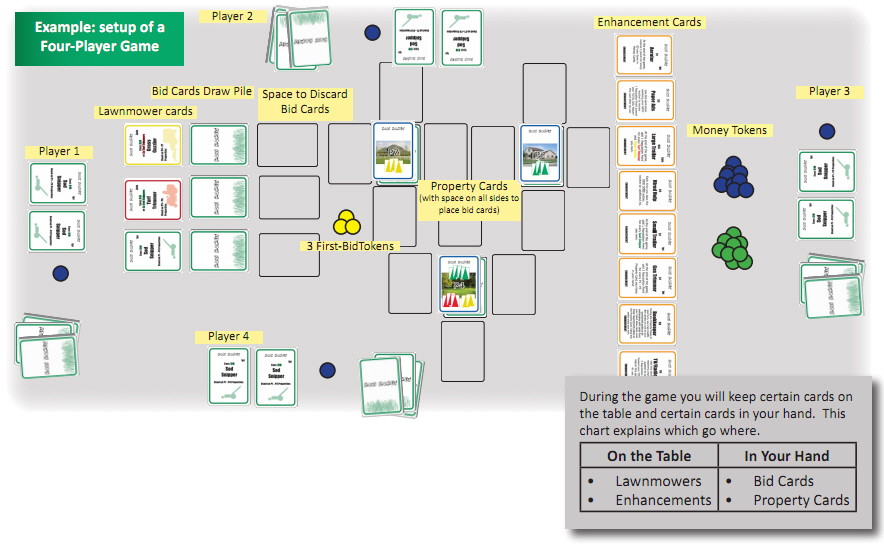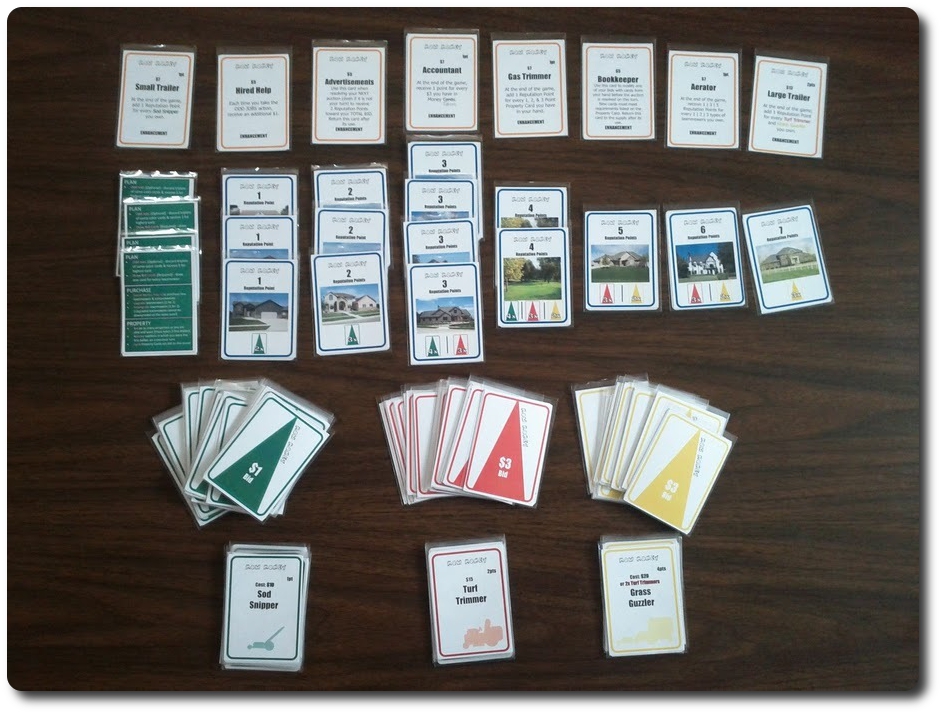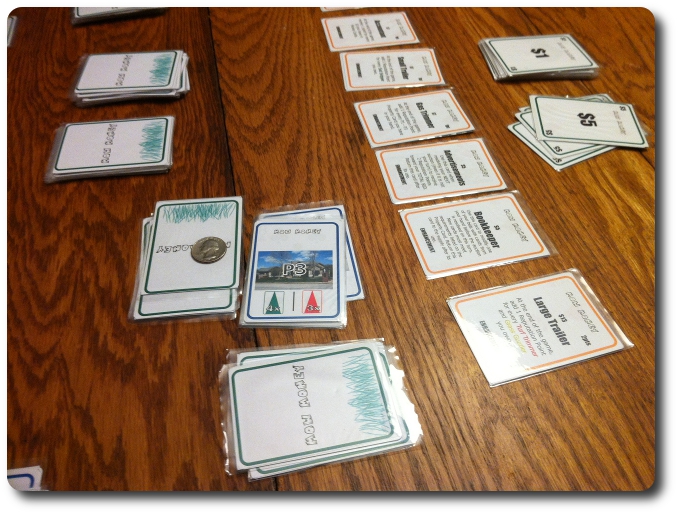
The Basics:
- For ages 10 and up
- For 2 to 4 players
- About 45 minutes to complete
Geek Skills:
- Counting & Math
- Logical & Critical Decision Making
- Reading
- Color Matching
- Strategy & Tactics
- Risk vs. Reward
- Hand/Resource Management
- Bidding
Learning Curve:
- Child – Hard
- Adult – Easy
Theme & Narrative:
- Spring is here, grass is growing, and there is money to be made! Gas up your lawnmowers and out bid your competition to be the most successful landscaping company in town!
Endorsements:
- Gamer Geek approved!
- Parent Geek approved!
- Child Geek untested!
Overview
In Mow Money, the second entertaining offering by game designer Matt Saunders, creator of Mow ‘Em Down, each player takes on the role of a landscaping company owner with a few lawnmowers, little money, and big dreams. Game play is quick and engages all players from start to finish. Each and every decision made could be the first step to total victory or to complete defeat. The player must think ahead and make good business decisions, carefully balancing risk vs. reward, to be as shrewd and thrifty as possible while still making a profit.
NOTE: Mow Money is an unpublished game. As such, all rules, cards, and game play details that follow are subject to change. Download the latest rules and the game itself from Board Game Geek.
Mow Money is comprised of 110 cards in total The card types include Money (in $1, $3, $5, and $10 denominations), Lawnmowers (3 different types), Bids (3 different values), Enhancements, and Property. Not included but needed in the game are at least 3 tokens or markers which are used during the bidding portion of the game. All text on the cards are easy to read and very straight forward. Flash has been pushed to back in the interest of making each card exceptionally informative without being heavy or misguiding. Colors are also used to determine the different card types which makes it very easy to separate the cards and set up the game. The instructions are also very straight forward, provide visual examples, sidebar summaries, quick reference to all the different cards, and a turn order summary. Taken as a whole, the only thing separating this game form a published game is product quality and a publisher’s name. Mr. Saunders’ passion for his creations and his sharp eye for detail shows once again proving that indie games can very much be as good, if not better, than published games.
Game Set Up
While Mow Money is a card game, you will need a good deal of playing space, both for all the cards not in play and the cards in play owned by the player and available to all players at the table. It is highly recommended that you play this game on a good-sized family or gaming table.
To set up Mow Money, sort the Money cards into two different stacks. The Money cards are double-sided, with $1/$3 cards and a $5/$10 cards. Lay out all the Enhancement cards, face-up. Sort the Lawnmower cards into the three different types (easily recognized by color and name). Sort the Bid cards into three different types, as well (also easily recognized by color). Make a stack for each type and shuffle the Bid cards. Place each stack, face-down, next to the Lawnmower cards (green Bid deck next to the green Lawnmower cards, for example). Ensure there is enough room for a discard pile next to each Bid stack.
Shuffle all 15 Property cards. Depending on the number of players you have, you will deal out a different number of Property cards for the game. For a four-player game, deal three stacks, face-down, for a total of 5 cards in each stack. In a three-player game, randomly remove 3 cards from the stack (removing these cards from the game) and deal two stacks of 6 cards each. For a two-player game, randomly remove 5 cards from the stack (removing these cards from the game) and deal two stacks of 5 cards each. Regardless of the number of stacks, they should be placed in the center of the playing area and have enough room for four card piles (used in bidding) around each Property stack. Once placed, flip over the top Property card of each stack, face-up.
Finally, give each player 2 Sod Snipper Lawnemower cards, 1 $5/$10 Money card, and 3 green Bid cards.
The Money and Lawnmower cards are placed in front of each player, face-up. The Bid cards are kept in the player’s hand and should remain secret.
When completed, your game set up might look something like the following.

The game demands a good amount of space - don't worry, it is well worth it
You are now ready to play the game! But before you do…
About the Cards
As previously mentioned, the cards are very well labeled and the information is clear and crisp. The game designer kept the game simple in this respect, but not to a point where it reduces the game’s effectiveness and depth.
Each card has a specific role to play. A unique game mechanics is that most of the cards a player will own are visible to all the players. Only Bid and Property cards are hidden. This makes it easy for others to know what your landscaping company has in regards to resources, but the bidding power of each player is kept secret. This adds an interesting challenge to the game as it allows all the players to understand each player’s potential strength without ever truly making it clear what their absolute worth is.

Lots of cards but very manageable
The Money cards are double-sided and are used by the players to buy equipment and enhancements. While playing with them, the players will flip the cards over to show its current worth. If change is needed, the player can draw new Money cards and put correct value of the card face-up to show its current value. It is important to note that the card itself is only worth the value it is showing.
Everything else about the cards should be self-explanatory.
Mow That Grass!
There are three phases a player completest on their turn. These are the Plan, Purchase, and Property phase. Each phase is done in order but what actions are taken in each phase is up to the player.
The Plan phase has two actions, one optional and one required. This phase allows the player to obtain more money and to improve their overall bid strength.
- Odd Jobs (optional): the player can discard three Bid cards of the same color (green, yellow, or red) to obtain Money cards. The total value of the Money cards given to the player is equal to the highest value of the three Bid cards discarded. Theme wise, the player is giving up their bidding strength because they are busy doing smaller jobs for a set price.
- Draw New Bid Cards (required): the player draws one Bid card for each Lawnmower card they have. The Bid card drawn matches the color of the Lawnmower card. For example, if the player had a green Sod Snipper lawnmower, they would draw one green Bid card.
The Purchase Phase allows the player to buy, trade, and enhance their equipment. All actions during this phase are optional and can be done multiple times.
- Buy New Lawnmower: the player spends their Money cards to purchase new lawnmowers. Once a new lawnmower is purchased, immediately draw 3 Bid cards that matches the new Lawnmower card color.
- Buy Enhancements: the player spends their Money cards to purchase an Enhancement card, placing it down in front of them.
- Upgrade Trade-In: the player can trade in 2 Lawnmowers of the same type to upgrade to the next Lawnmower. Unless the player still has at least one Lawnmower of the type they just traded in, they must discard all the Bid cards of the same color (including Bid cards used in bids). Otherwise, they keep their Bid cards and immediately draw 3 Bid cards that match the new Lawnmower color.
- Downgrade Trade-In: the player trades in one Lawnmower for 2 Lawnmower cards of the next lowest level. Note that you cannot downgrade an upgrade made in the same turn. Unless the player still has at least one Lawnmower of the type they just downgraded, they must discard all the Bid cards of the same color (including Bid cards used in bids). As a penalty for downgrading, the player only draws 1 new Lawnmower card of the same color as the Lawnmower cards just acquired.
The Property Phase is the most complicated portion of the game. The only required action is Resolve.
- Bid: place a number of Bid cards, of the same color indicated on the Property card, face-down next to the property being bid on. Optionally, the player can also add 1 of their previously obtained Property cards. The Property card has a “reputation value” that reduces the sum of the total number of cards played in the Bid, but not actually played on the bid itself. If the player is the first one to bid on the Property, they place a marker on their Bid stack to indicate this.
- Resolve (mandatory): if the player placed a marker on the Bid stack last round, they must now resolve the bid for that property. All players reveal their Bids. The player who has the smallest Bid value wins the Property card. To determine each player’s Bid value, add the number of Bid cards used and subtract that value by a played Property’s “reputation value”. For example, if a player bid 3 and placed a Property with a reputation value of 2, the player’s total Bid value would be 1. Note that all the Property cards used in the Bid are discarded. Resolved Bids end the player’s turn.
- Cycle: the player moves one Property card not yet bid on to the bottom of the Property stack and flips over a new Property card. This ends the player’s turn.
- Pass: the player chooses not to Bid or Cycle and their turn ends.
Out of Gas (and Grass)
The game continues until there are no more Property cards to bid on and the last auctioned Property card is claimed. At that time, each player has one more turn to complete their Plan and Purchase phase.
Players take their cards and count the total number of reputation points. The player with the highest reputation wins the game.
Prediction
My oldest little geek enjoyed Mow ‘Em Down, but had a very difficult time understanding the game. Mow Money is even more abstract and has a much heavier bidding and economic element to it that I am certain is well beyond my oldest little geek’s, at age 7, capabilities. This didn’t stop me from introducing the game to him, however.
My two oldest little geeks sat down at the table and I started to explain the rules to them, how the cards interact, and how a player goes about building their landscaping empire. I lost them somewhere around the rules and cards. The game just has too much going on without enough visual “pizzazz” to keep my oldest little geeks interested. My 4-year-old excused himself from the table to get our copy of Rattlesnake to play with, but my 7-year-old stuck it out and listened to my game explanation and examples until I was finished. When I answered all of his questions, gave him a few examples of how the bidding worked, and important points to consider during each phase of the game, I asked him his thoughts on Mow Money so far.
“It looks neat, Dad, but I don’t have any idea about half of what you were talking about.” ~ Liam (age 7)
“Look, Dad! My snake eggs are a bracelet!” ~ Nyhus (age 4)
Well, you can’t win them all. Looks like Mow Money is going to be a game untested with my little geeks for now. Time to find some parents and gamer geeks!
Final Word
Mow Money feels like a faster, streamlined version of Mow ‘Em Down, and if pushed against the wall, I’d point to Mow Money as the clear winner. The game itself benefits a great deal from its predecessor and I am most pleased to see the game designer learning from his earlier projects to create better games. I’d go so far as to say that Mow Money is a one of the better bidding card games I have played in a long while.
My biggest gripe about the game is the area it takes the play the game. There are a lot of cards and all those cards take space. I don’t know how the game designer could address this, however, without impacting the game in a very negative way. All the cards are needed, used, and enjoyed. As such, I’m happy to just frown slightly as I play on the edge of the table while the cards take up all the room. You know, now that I think about it, the problem might just be my family gaming table is too small. I’ll bring this up to my wife later…
And let us not forget this game is free to download, print and play. When you consider that the game designer spent time and energy to make a game that plays fast, is well thought out, intelligent, and challenging to a point where you can easily see this being on a game shelf in a game story, you can’t help but get all mushy over it.

Game in progress and already feeling the pressure!
Gamer Geeks, you are going to enjoy this game! It is fast, challenging, deep, and heavy. All the things game elitists usually pride themselves in enjoying while less enthusiastic game players focus on lighter games to pass the time. You can get a copy of the game by downloading the free Print-and-Play copy from Board Game Geek. You will particularly enjoy the speed in which the game is played without reducing the level of player decision making.
Parent Geeks, when your little geeks are ready and when you want an enjoyable family game, Mow Money is right for you. In fact, download it now and print it out. Play it with friends and introduce your little geeks to it gradually as their geek skills mature and their interest grows. This is a wonderful game to introduce concepts of risk vs. reward and proper management of resources. In today’s economy, everyone could benefit from a fun lesson of proper money management. For those of you who have non-gamer friends, don’t bother bringing Mow Money to the table. This game will blow their minds and leave them feeling run over by a truck. Never mind that the truck is built out of a wonderful card game.
Child Geeks, this will be a challenging game for you. The game designer’s suggested age of 10+ sounds exactly right. The game itself is not difficult in regards to what you have to do and when, but there is a lot going on “behind the cards” that will frustrate you if you play this game too early. Practice your geek skills on other games like Bohnanza, Launch Pad, and Farmageddon first. These lighter games will help put you on the path to playing Mow Money like a pro!
My biggest regret is that my oldest little geek is not yet ready to play this game. I greatly enjoy playing it, find it to feel strangely Euro’ish and heavy without being weighed down. It is just the right amount of game played in the right amount of time. I have played and lost, and played and won several times and each game experience teaches me something new about myself and how I measure the “value” of my personal standing in the game. There is a lesson to be learned here, I’m sure, but I’m too busy enjoying the game to make it stick.
In conclusion, Mow Money is a fantastic game made even more fantastic by the fact you can go grab it right now, print it off, and play it tonight. The game designer takes his games seriously and his passion for playing and having fun is exceedingly visible. Do go get your hands on this game and enjoy the labors of a true geek!




Thanks for the review! Just wanted to let fans of Father Geek know that the latest version of Mow Money has been posted on Board Game Geek, ready for download: http://boardgamegeek.com/boardgame/108679/mow-money
In this version, phases are now played one at a time in turn order. This change speeds up the game even more and keeps player downtime to a minimum. I have also changed the Enhancement Cards to now include both “In-Game” effects and “End-of-Game” bonuses. This creates for more interesting choices during the game.
Enjoy!
As with any indie designer, I live for feedback. If you download, print and play Mow Money, I’d love to hear about it. Post a comment, review, play session, rating, etc. on the game’s entry on Board Game Geek.
Peace,
Matt
Thanks for the update, Matt!
Did you know that Mow Money was a finalist in the Protospiel Card Game Design contest?
Well now you do.
And knowing is half the battle!
Wait, that’s G.I. Joe… man, I miss the 80’s and being 10-years-old…
But to your point, yes, Matt did let me know. And for those of you reading this that have no idea what David and I are talking about, check this out.